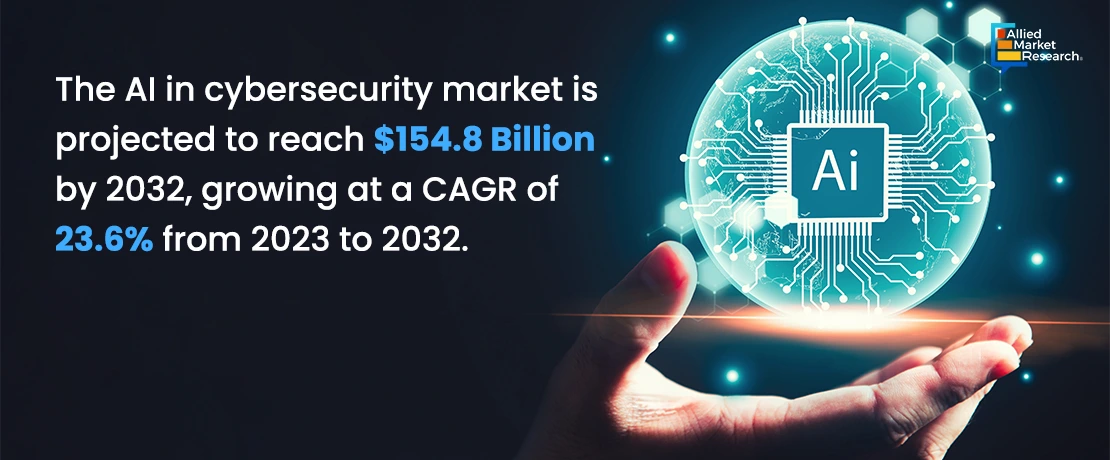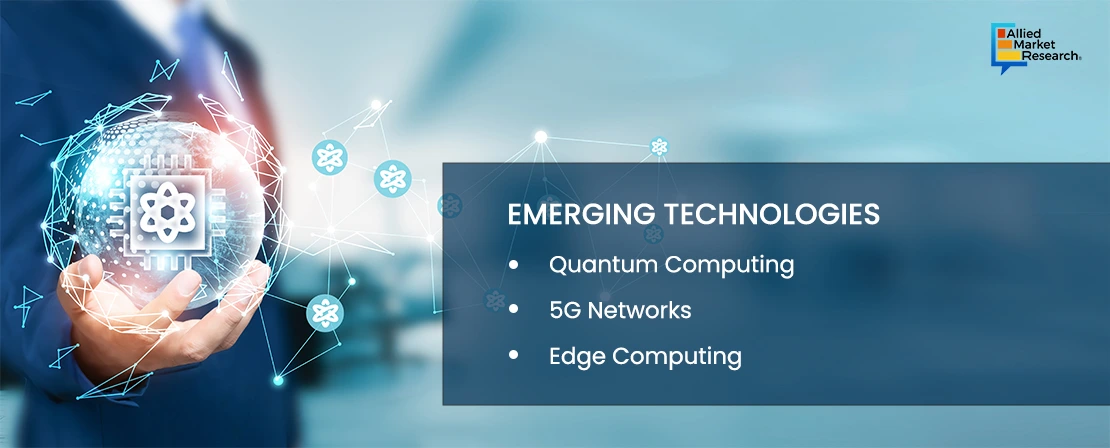Table Of Contents

Onkar Sumant

Pooja Parvatkar
AI in Cybersecurity Technology: Addressing the Concerns in Network Safety

Artificial intelligence (AI) in cybersecurity is referred to as a combination of technologies like machine learning and deep learning in cybersecurity. AI is assisting under-resourced security operations’ experts to maintain ahead of threats as the number and complexity of cyberattacks increase. Response times are significantly reduced by using AI technologies like machine learning and natural language processing, which offer quick insights. AI in cybersecurity can examine enormous volumes of data to find patterns and irregularities that can point to malicious activity.
AI-powered solutions can continuously monitor networks, endpoints, and systems, allowing for quick reaction and real-time visibility into any security breaches. This further leads to more accurate and effective security operations.
The AI in cybersecurity market is projected to reach $154.8 billion by 2032, growing at a CAGR of 23.6% from 2023 to 2032. The rising incidence and sophistication of cyberattacks have prompted enterprises to pursue sophisticated and pioneering defense solutions, anticipated to further bolster the expansion of the artificial intelligence in cybersecurity market. Additionally, the proliferation of IoT devices across various domains and the consequent increase in data generated by these connected devices present lucrative prospects for the global AI in cybersecurity market. Furthermore, the escalating demand for adaptable security services among businesses is projected to drive the growth of the market.

The Traditional Approach to Cybersecurity Before the Advent of AI
Before the advent of AI, traditional cybersecurity heavily relied on signature-based detection systems and manual analysis. These systems compared incoming traffic to a database of known threats, leading to high false positives and vulnerability to new threats. Security analysts manually investigated alerts and logs for breaches, while rule-based systems enforced network behavior policies. However, this reactive approach was ineffective against new threats and generated false positives, draining resources. AI's introduction revolutionized cybersecurity by enabling proactive threat detection, adaptive defenses, and automated response mechanisms, significantly enhancing security capabilities.
The Notable Evolution
In 2023, the cybersecurity landscape continued to evolve dynamically, showcasing the rapid emergence and adoption of novel technologies aimed at bolstering threat detection capabilities, analyzing extensive datasets for anomalies, and automating security operations. Concurrently, the realm of cyber threats exhibited a trajectory towards heightened sophistication, necessitating vigilant adaptation and proactive measures to safeguard against evolving risks.
In 2022, 76% of organizations were targeted by a ransomware attack, of which 64% were infected. To more effectively defend against such attacks, it is important for cyber professionals to understand current trends and challenges that exist in the field of cybersecurity.
A Growing Threat Landscape
The threat landscape continues to expand with the increasing connectivity of devices and systems through the Internet of Things (IoT) and the proliferation of digital technologies. Cyberattacks such as ransomware, phishing and insider threats remain pervasive and pose significant risk to enterprises, governments, and individuals alike. While these threats are familiar, the escalating volume of data production and storage, coupled with global connectivity, has rendered the attack surface increasingly exploitable.
Consequently, there are enticing gaps and vulnerabilities for criminal and nation-state hackers to exploit. In 2023, cyberthreats notably rose as unrest around the world contributed to an increase in cybercrimes. Malware attacks (e.g., ransomware attacks) are also expected to target more enterprises.

How AI is Used in Cybersecurity
AI is being used in cybersecurity to detect and respond to cyber threats in real-time. AI algorithms can analyze large amounts of data and detect patterns that are indicative of a cyber threat. In malware detection, AI algorithms go beyond traditional signature-based methods to analyze behavior, identifying both known and unknown threats. Likewise, AI-driven phishing detection solutions scrutinize email content and user actions to flag potential phishing attempts, surpassing rule-based filtering limitations. In security log analysis, AI algorithms analyze vast data volumes in real-time to spot patterns and anomalies indicative of breaches, enabling swift responses. Network security benefits from AI-driven anomaly detection, monitoring traffic and device behavior for suspicious activity. Endpoint security is enhanced by AI solutions analyzing behavior to detect threats in real-time, providing adaptive defense against evolving cyber threats. Thus, AI's integration into cybersecurity operations delivers proactive threat detection, adaptive defenses, and expedited response mechanisms, greatly enhancing organizations' ability to mitigate cyber risks and safeguard sensitive information.
Transformative Applications of AI and ML in Today’s Modern World
Since the launch of ChatGPT in November 2022, there's been a surge of interest in AI, particularly generative AI, and its role in ensuring secure outcomes. Although AI has long been utilized in security, with machine learning (ML) previously employed for generating malware signatures, its application continues to evolve.

One enduring use case of ML is in User and Entity Behavior Analysis (UEBA), where it identifies abnormal behaviors by scrutinizing various aspects like device configurations, application usage, data flows, sign-ons, accessed IP addresses, and network traffic patterns.
Many vendors integrate UEBA into Security Information and Event Management (SIEM) systems, enhancing anomaly detection capabilities. Moreover, ML models within SIEMs effectively identify sophisticated threats like Domain-Generated Algorithms (DGA) utilized in DNS attacks, reinforcing cybersecurity measures.
Potential Use Cases for AI and ML
Vendors are increasingly turning to AI to automate mundane security tasks, allowing human analysts to focus on more complex issues. While AI can efficiently translate between languages and streamline investigations by providing context around alerts, it's limited to recognizing what it's been trained to see. SIEM (security information and event management) vendors commonly use rules to correlate alerts into incidents for analysts, who may benefit from AI-generated context and prioritization of alerts. Trusted AI systems could suggest or even execute playbooks based on analysts' regular actions, with generative AI providing recommendations via chatbots. Over time, organizations may develop predictive threat models using their own data and threat pattern recognition capabilities. AI's role in simplifying and accelerating security operations is expected to continue evolving, offering valuable support to analysts in navigating the increasingly complex cybersecurity landscape.
AI Data Management
Data holds significant weight and importance, particularly in security contexts where even more emphasis is placed. For instance, a standard endpoint protection platform agent generates approximately 150-200MB of data daily, leading to scalability issues in its movement, storage, and management.
Leveraging AI is essential to effectively harness the expanding pools of telemetry data. While machine learning has its limitations, employing AI to identify novel patterns and insights within the data can substantially reduce the time-to-insight.
The significance of data weight is evident in competitive strategies, such as infrastructure-as-a-service (IaaS) providers offering to retain cloud logs at minimal or no cost. This move holds importance, particularly as Security Information and Event Management (SIEM) solutions are often priced based on data volume ingested. Adaptations in the business models of SIEM, Extended Detection and Response (XDR), and other analytical platforms are inevitable as they grapple with the challenges posed by the substantial weight of data.
Cybersecurity operations heavily depend on detecting threats, with AI playing a crucial role in analyzing extensive datasets and identifying anomalies in user behavior. For example, AI can detect unusual activities resulting from a phishing attack, providing insights beyond traditional security measures. By utilizing AI, security teams can effectively prioritize and respond to genuine threats among the multitude of potential risks encountered daily. IBM's incorporation of AI into its QRadar Suite serves as a prime example, offering a unified platform for detecting and addressing security threats. Through AI-driven automation, security teams can streamline their processes, enhancing both speed and efficiency in handling incidents.
Emerging Technologies
The rapid adoption of emerging technologies like quantum computing, 5G networks, and edge computing presents new cybersecurity challenges across various domains:
- Quantum computing:
- Encryption vulnerabilities: Quantum computers have the potential to compromise widely used encryption methods such as Rivest–Shamir–Adleman (RSA) and elliptic curve cryptography (ECC), raising concerns about data privacy and integrity.
- Post-quantum cryptography: Developing and implementing post-quantum cryptographic algorithms resistant to quantum attacks is crucial for maintaining secure communication.
- 5G networks:
- Increased attack surface: The widespread deployment of 5G expands the attack surface due to more connected devices and increased data transmission.
- Network slicing and virtualization: Dynamic features of 5G networks introduce vulnerabilities, emphasizing the need for proper segmentation and isolation.
- Edge computing:
- Distributed security: With edge computing, data processing and storage are decentralized, posing challenges in maintaining consistent security protocols across a distributed infrastructure, emphasizing the need to effectively secure edge devices, gateways, and communication channels.
- Latency and bandwidth constraints: Emphasizing low-latency and real-time processing, edge computing may constrain resources available for comprehensive security measures, necessitating a delicate balance between security requirements and latency/bandwidth constraints to avert vulnerabilities and ensure data integrity.
These technologies bring opportunities for innovation and efficiency, they also provoke concerns about their potential impact on security, privacy, and data integrity. It is essential to prioritize research and development in secure quantum-resistant cryptography, network segmentation, threat detection and secure architecture design to mitigate risk and address the evolving cybersecurity landscape introduced by these technologies.
Conclusion
The state of cybersecurity in 2023 is marked by a dynamic and evolving threat landscape, regulatory compliance and privacy concerns, and the increasing use of AI and ML, among other trends. Organizations and individuals must remain vigilant, proactive, and adaptive to effectively address these trends and their accompanying challenges and protect against cyberthreats. Staying updated with emerging technologies, compliance requirements and best practices, while building a skilled cybersecurity workforce, is crucial for effective cybersecurity in the current landscape. This is where AMR can step in to help your businesses. Contact AMR analysts for comprehensive insights.

